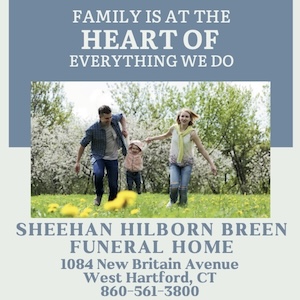By Cindy Mindell ~
COLCHESTER – What started two years ago as a quiet, garden-variety lawsuit in this small town has lately become a cause celebre of the national media, as accusations of racism pepper news reports and blogs across the country.
At question is a section of a Jewish cemetery developed for interfaith burials, and the contractual validity of both the cemetery and the first interment. The legal case that now fascinates the media is pending, slated for a March court date.
The backdrop for this case is set in 1999, when the Orthodox Colchester Jewish Aid Congregation merged into the Conservative Congregation Ahavath Achim. The resulting agreement combined the synagogues’ assets, including three cemetery properties. Ahavath Achim owns two – one on New London Road that is no longer used for burials, and an active cemetery on Taintor Hill Road. Jewish Aid’s cemetery, on Gillette’s Lane, included a tract of undeveloped wooded land not used for burials at the time of the merger.
Regarding the cemetery properties, Clause 6 of the certificate of merger is of particular note. Sub-clause C states, “The Congregation Ahavath Achim Incorporated shall provide all necessary improvements, including but not limited to replacement of fence and paved driveway and distribution of topsoil and seeding as necessary, to restore the cemetery to a similar condition as the Congregation Ahavath Achim Cemetery on Linwood Cemetery Road. The work described in this subsection shall be completed within (12) months of the execution of the agreement herein.”
Sub-clause F states, “The Congregation Ahavath Achim shall use its best efforts to reserve Rows A through H of the Colchester Jewish Aid Congregation’s Cemetery on Gillette’s Lane in Colchester for the members set forth on Schedule B, attached hereto. Furthermore, the Congregation Ahavath Achim shall not allow anyone of the non-Jewish faith to be buried within the confines of Rows A through H of said cemetery or any other cemetery properties of the former Colchester Jewish Aid Congregation.”
This clause is at the heart of a legal dispute between longtime congregant and board member Maria Balaban, the synagogue, and the brother of the first person to be buried in the new interfaith section of the congregation’s cemetery.
This is a story of interpretation – both of a legal contract and of American Jewish life in the 21st century.
A few years after the merger, the congregation began a conversation not unfamiliar to Reform and Conservative synagogues.
“We began to think and talk about the possibility of having an interfaith cemetery in Colchester,” says Ahavath Achim president, James Seger. “We recognized that there were changing social conditions in the U.S. – the family structure and traditional marriage were changing, and the rate of interfaith marriages was growing tremendously. In our own congregation, we had a growing number of interfaith marriages. We thought that it would be nice if there were a place for these people, who would like to be buried in the Jewish tradition.”
By 2003, the conversation got serious and the Ahavath Achim board chose an area in the former Jewish Aid Congregation cemetery that seemed most suitable for an interfaith area.
Most of the board members agreed that the yet-undeveloped wooded area would meet the need, as it was “visually separate” from the rest of the cemetery, in Seger’s words. To prepare the site, the synagogue would remove trees, re-grade the site, install fencing as a mechitza, and pave the driveway throughout the entire cemetery.
Like the two original Ahavath Achim cemeteries, plots would be offered for purchase to the general public, not only synagogue members, but all burials “would have to follow traditional Jewish customs,” Seger says.
Maria Balaban has been a member of the synagogue for 49 years, first at Jewish Aid, where she was married, then Ahavath Achim, where she has served on the board for 40 years and where she and her husband have each served as president for three terms.
Balaban says that, since the merger in 1999, she had been reminding the board to repave the cemetery driveway, referring to the certificate of merger. In 2008, the job was finally completed, and Balaban had become very familiar with the merger contract.
As plans for an interfaith cemetery were being finalized, Balaban noted another clause in the contract, stating that the synagogue board must include two members of the former Jewish Aid Congregation for a 10-year period, and that the cemetery committee must also include two Jewish Aid congregants.
“But there was never anyone from Jewish Aid on the cemetery committee,” Balaban says. In addition, she says, the two Jewish Aid board members active at the time of the merger died before the stipulated 10-year period, and were never replaced with other Jewish Aid members. She says she brought the matter to the board’s attention, to no avail. (Today, according to Seger, there are some 20 former Jewish Aid members among the Ahavath Achim congregation.)
Balaban says that the board’s discussion of an interfaith cemetery centered around the burial of non-Jewish spouses, children, and grandchildren of Ahavath Achim members, not the general public.
“As a board member, I voted no,” Balaban says. “I don’t believe that should happen in the Jewish Aid cemetery: it’s an Orthodox cemetery and my whole family is buried there. Ahavath Achim has a Conservative cemetery, and the interfaith section can be included there. ”Balaban and her husband own plots in the Jewish Aid cemetery.
In an interview on the subject with the Associated Press, David Berger, dean of the Bernard Revel Graduate School of Jewish Studies of Yeshiva University in New York City, noted that Jewish laws and practices prohibit the burial of non-Jews in Jewish cemeteries.
“Jews should be buried with other Jews. There is such an expectation,” Berger told AP.
(The Ledger asked several rabbis throughout Connecticut to comment on Jewish law regarding burial. None responded.)
Seger claims that the 2009 board vote was unanimous. “Mrs. Balaban did not vote in opposition,” he says. “There was no discussion to the contrary; it was fair and inclusive.”
Once the interfaith cemetery was opened, four plots were purchased by two Jews both in interfaith relationships, and both intending to use the plots for themselves and their non-Jewish significant others.
In early 2010, the board was informed that a woman, Juliet Steer, had called to request a plot in the interfaith cemetery. “My question was, ‘Is she Jewish?’” Balaban recalls. “They told me that she claimed her mother, who was dead, told her that her father had some Jewish relatives.
Steer, who was terminally ill with cancer, died in April of that year. After she was buried – the first person to be interred in the interfaith section – Balaban again reminded her fellow board members of the clause pertaining to the governing body’s structure. Because the board and cemetery committee had been exclusively comprised of Ahavath Achim members when the interfaith cemetery was created, Balaban saw the cemetery as a breach of contract and therefore illegal. By extension, Juliet Steer had been unlawfully buried and should be reinterred in another location.
“We each interpret the merger agreement a different way,” Seger explains. “The plaintiff says that no non-Jews can be buried anywhere in the Jewish Aid cemetery, even the wooded part that wasn’t being used for burials at the time of the merger. We say that only rows A through H cannot be used for non-Jewish burials.”
Two motions have been filed by Ahavath Achim. The first, suggesting that Balaban choose another place of burial, was dismissed. “The judge said that I am not fighting for my plot; I am fighting for the contract,” Balaban says.
The second motion is at the center of the national media hubbub, as reflected in the AP’s story, “Race Questions Cloud Lawsuit Over Jewish Cemetery,” and is the subject of the March court hearing.
The synagogue and Paul Steer, Juliet’s brother, are charging Balaban with “unclean hands and laches.” The first charge is related to “derogatory comments” that Balaban allegedly made about Juliet Steer, who is black. The second charge correlates to the synagogue’s claim that Balaban approved the creation of an interfaith cemetery, and then, as Seger says, “it’s as if the plaintiff changed her mind.”
The motion states that defendant Paul Steer is black, as was his deceased sister, and that the plaintiff is white. It goes on to say that Juliet Steer was the first person of color to be buried in the interfaith cemetery and that the plaintiff has approved the burial of non-Jews who are white, and has made derogatory comments about Steer’s color and race.
The final charge in the motion reads, “The Plaintiff’s real motivation in this case is to remove the interred remains of this black woman.”
Still, Seger insists that the case is not racially based. “This is not a race issue,” he says. “Unfortunately, this issue has taken an ugly twist with racial overtones.”
Seger says that it was undue attention to a list of questions submitted by the synagogue that led to the allegation in the media.
“Some time ago, our side submitted to the court a list of questions we wanted to ask the plaintiff, and she submitted her own list,” he says. “A couple of those questions we submitted were race-related and it’s a public document filed with the court. That was seen by the first reporter and he jumped on that.”
Balaban rejects any accusation of race-based motivation. “I didn’t even know the lady was black until five days after the burial,” she says.
A retired social worker, Balaban, 72, points to her track record working with minority populations throughout her 18-year career in Willimantic. She says she’s proud of the awards she received for her work with youth groups and for helping to expand affordable-housing and daycare opportunities for low-income families.
Both sides agree on one thing: they’d rather not be arguing with one another.
An Orthodox Jewish cemetery should be a place where only Jews are buried,” Balaban says. “That’s the halacha. It’s a shame we’re fighting Jews against Jews.”
“The Jewish people have survived throughout the ages because we have learned to unify in times of strife,” says the Congregation’s spiritual leader, Rabbi Ken Alter, who has stayed above the fray. “We learn that our world has survived because of three things: Our Torah, our prayers and acts of loving kindness. We are a compassionate nation and have a tremendous amount of love in our hearts. When confronted by challenges we turn to God and ask for Divine assistance. When we can feel and listen to that small inner voice that exudes peace and calm we can weather any storm.”








 Southern New England Jewish Ledger
Southern New England Jewish Ledger










